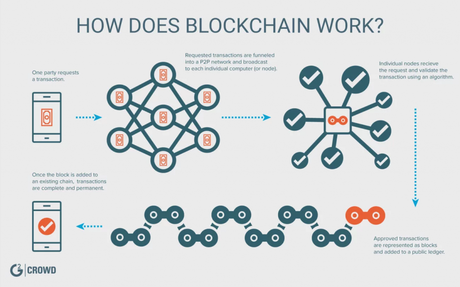
B2B digital transformation demands a lot of businesses. Rapidly evolving technology has forced companies to adapt quickly without always knowing the outcomes. For B2B marketers and new entrepreneurs, it's important to understand not only the definition of terms like IoT and blockchain. We need to understand how they may impact businesses in the near future.
G2 Crowd, the world's largest B2B software and services review site, has identified digital that look beyond buzzwords and industry jargon. AI, blockchain, and IoT are actual tools driving change in today's technological landscape. In this post we turned to Aaron Walker, Senior Research Specialist for G2 Crowd focusing on software development and cyber security technologies, to help walk us through how these technologies work.
What is B2B Digital Transformation?
The term "digital transformation" can mean a lot of things. The trends outlined here are classified across AI, digital platforms, and IoT-related concepts. Integrating new technology related to these trends is not a simple process. Companies and managers must identify the proper fit in order to complement their business's operations, strategies, and objectives. It's easy to get distracted by AI-powered tools or blockchain-based applications, but the tools' actual benefits depend entirely on successful adoption.
Powerhouse corporations like GE are already demonstrating ideal digital transformation practices. While their stock value took a hit, earning the title of worst performing stock of 2017 and losing about 40 percent of its value, the company appears to be successfully evolving to focus on the future by investing in AI and IoT. Despite being well over a century old, GE exemplifies the prototypical example of enterprise-scale digital transformation. The company has embraced SaaS-based subscription models to help bridge a gap between industrial markets and emerging technologies. Predix, their new digital platform, is linking commercial appliances and manufacturing endpoints to IoT automating the supply chain and driving greater efficiency for the organization.
Where does Artificial Intelligence fit in?
If you're in marketing, AI is the future. If you're Elon Musk, it's the end of the world. While it's entirely possible, skynet-scale destruction appears a lot less likely than the emergence of tools with AI-driven analytics and intelligent automation.
There are three main components of AI that are going to be most impactful where B2B digital transformation is concerned. This includes embedded intelligence, machine learning as a service (MLaaS) and open data. Embedded AI within an application can add a range of capabilities from predictive analytics to helpful chatbots. It's already impacting spaces like the ERP market, where the embedded AI provides insights based on historical data and predictive services based on the reaction of prior performance and previously unidentified, or external catalysts. AI-based SaaS applications have hit multiple markets through MLaaS. For example, CRM software solutions like Salesforce's Einstein utilize embedded AI to expand automation from thousands of diverse datasets to improve lead scoring, prospecting and save time overall. Microservices providers like Amazon, Microsoft and Google are hoping MLaaS solutions will be as lucrative as their SaaS, PaaS, and IaaS solutions have been. MLaaS opens the door for startups to plug in machine learning APIs, instead of developing their own unique algorithms.
Open data is a bit less tangible than the embedded AI, but can drastically improve the range of information an AI solution is processing. Open-source and shared datasets can add additional image, geospatial, text, and transport data for big data processing engines to consume and spit out.
Data-sharing won't be confined to the CRM space, as businesses become more inclined to share their data if it means exponentially more in return. Giving up some information to the public is not absurd to ask if it means additional information and significantly improved predictive analytics, automation, and accuracy.
What about Blockchain?
Blockchain technology will facilitate a wide range of capabilities for a number of industries. The biggest impacts will be seen in Fintech and Finserve markets, but it's already being applied to cloud storage, security, and supply chain applications. Transaction-centered offerings are already embracing the idea of blockchain for its encryption and transparency characteristics. It can improve sensitive data security for e-commerce payments or financial managers and streamline operations with frictionless payment processing. Industry leaders like Goldman Sachs, Santander and BNY Mellon are already leading the way while similar firms continue pushing enormous amounts of money into blockchain technology.

Security has been the second largest industry impacted by blockchain technology. Some companies are using it to protect everything from large-scale IoT networks and access management systems to streaming data and cryptocurrency storage.
Other markets embracing the technology include virtually every industry that can benefit from secure transactions or data encryption. A few cloud storage and database companies have embraced blockchain to distribute storage and encrypt files. Any number of SaaS tools could integrate some kind of blockchain as a service to instantly bolster security.
The Promise of IoT
IoT is rapidly transforming manufacturing, agriculture, and shipping industries, just to name a few. Internet-enabled machines from medical appliances to assembly equipment can become self-reliant, self-fulfilling, and self-monitoring.
IoT has led to an enormous influx of information and enabled companies to amass, analyze and distribute data in an innovative and accessible way. It's even caused some experts like G2 Crowd's Kara Kennedy to proclaim it "..the next industrial revolution."
Edge computing is another IoT-focused trend that improves computing and data processing by localizing initial storage before cloud deployment. The practice decreases latency and improves efficiency. GE's Predix is designed to support thousands of edge devices, enabling faster processing with low latency, making analytics more efficient and impactful.
Industries like manufacturing, that appear less technologically innovative on the surface, are embracing IoT through the use of digital twins, which provide virtualized replications of hardware appliances. It's a proactive model that can reduce endpoint failure and strengthen machine analysis through continuous monitoring. Within B2B digital transformation IoT will play a major role no matter the industry.
Digital Platforms continue to support B2B Digital Transformation
Microservices, PaaS, IaaS, and every other "aaS" offering provide a significantly more dynamic application model than traditional development. Today's technological ecosystem continues to expand the use of microservices, containerization, and serverless computing technologies to manage core business functions.
The microservice architecture provides a malleable, interchangeable application model to quickly add or remove desired functionalities. It's the basis for widespread offerings from service providers like AWS and Microsoft that deliver virtually any capability a company could want from virtual machines and deployment tools to development environments and database migration.
Containerization technology, prompted by the emergence of Docker, is improving security and development speed while expanding application functionality. Containerized applications, stored within portable, distributed components help companies reduce failover through segmentation and reuse existing application components. Resource isolation also improves efficiency and optimize networks.
Serverless computing, the final component of our digital platform trends, is a rapidly evolving model that allows users to manage applications locally and allocate resources as needed, rather than relying on dedicated servers. A Markets and Markets report predicts the serverless market will grow from a $1.88 billion market from 2016 to $7.72 billion by 2021 (411 percent). The technology will improve scalability, security, and agility for application management.
ConclusionCompanies developing these products and embracing their related solutions will continue to garner attention and gain traction. They'll lead the way for their competitors and probably be more inclined to receive venture capital funding if they're in start-up mode. Many of these technologies have significant overlap and will complement each other, improving each independent tool's capabilities. Successful adoption of an AI or IoT platform may set companies ahead of the pack, but cross-category utilization can build an ecosystem to be reckoned with.
